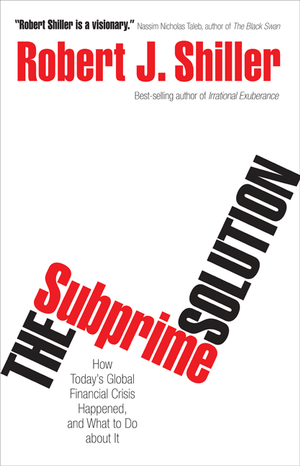
The Subprime Solution: How Today’s Global Financial Crisis Happened, and What to Do about It
by Robert J. Shiller
Bubbles and banking crises are not new phenomena. Robert J. Shiller recalls one housing boom in California, in the 1880s, as settlers rushed westward for “the wonderful climate, beautiful scenery, and California lifestyle.” Somehow, housing prices managed to escalate and collapse within that decade, despite the housing rush taking place in a state still vastly underdeveloped. How could a bubble occur, Shiller asks, when there was no sense of scarcity?
Though that century-old bubble might seem quite distinct from what we face today, they did have at least one common feature: both were propelled by what Shiller calls the “social contagion of boom thinking.” (Emphasis his.) That psychological territory is something Shiller, an economics professor at Yale, knows well from his last book, Irrational Exuberance, and will examine further in his upcoming book, co-authored with George Akerlof, Animal Spirits.
His choice of the word “contagion” is deliberate – he compares participants in a bubble to victims of an epidemic. In the 1880s, newspapers around the country trumpeted the bounty of California, and settlers, as noted in an old Los Angeles Times story Shiller quotes, had no idea why prices were skyrocketing, and had no sense that the boom was happening for any but a rational reason – that everyone wanted to live in California.
It’s not so different today. As Shiller notes, everyone in California still thinks everyone else wants to live here. And “social contagion lends increasing credibility to stories…that appear to justify the belief that the boom will continue.” Despite fairly steady labor and materials costs, and despite higher-density urban planning – or even the building of new cities and urban-seeming private developments – housing bubbles happen. Buyers have extraordinarily high expectations, Shiller found in a survey he conducted in 2005, that prices will keep rising, propelled by media accounts of the same.
And our attitude towards homes have changed, Shiller notes. Whereas we once saw them as depreciating goods – costly to keep up, and eventually outmoded, like a car – now we see them as investments with a guaranteed return. And, he argues, Americans now value the smart investor as fervently as we’ve always valued the hard worker.
Shiller’s solutions to prevent, or at least mitigate, future bubbles take into account a “paradox of Keynesian economic theory,” that short term pain can lead to long term benefits. Increased saving in the short run, for example, can deepen a recession, but it also provides resources for investment in the long run. For this reason, Shiller says, “The idea that public policy should be aimed at validating the real estate myth, preventing a collapse in home prices from ever happening, is an error of the first magnitude.”
For the short run, Shiller is not opposed to bailouts (and he provides an interesting history of the use of that term), as long as they are well targeted, like emergency care for the sickest during an epidemic. His long-run solution is ambitiously broad. Shiller proposes as innovative public and private sector reforms as the country accomplished in the 1930s, broadening or building risk-mitigating markets and institutions.
The final and most interesting solution – particularly for the general audience at whom this book is targeted – is Shiller’s call for the “democratization of finance.” His proposals – offering comprehensive financial advice for all, creating a consumer-oriented government financial watchdog, and creating easier to understand and more expansive data on the economy – do no less than create a new social contract, “one that dictates that we as a society will protect everyone from major misfortune and keep existing problems from spreading further, subject to the dictates of common sense.”
Excerpt: “[F]or several decades there has been as steady rise in economic inequality in the United States, as well as in most of the developed nations of the world. With each passing year, the continued worsening of that inequality further strains our tolerance of those who make large amounts of money in the financial markets. But this should not be an occasion for punishing the technology that has created the riches – for finance is indeed a powerful technology, and it can be a powerful means for making everyone better off…. A good deal of the economic inequality in the modern world is due to the persistence of unmanaged risks, and financial technology is ideally suited to deal with these risks.”
Further Reading: Irrational Exuberance and The Mystery of Capital: Why Capitalism Triumphs in the West and Fails Everywhere Else




Send A Letter To the Editors